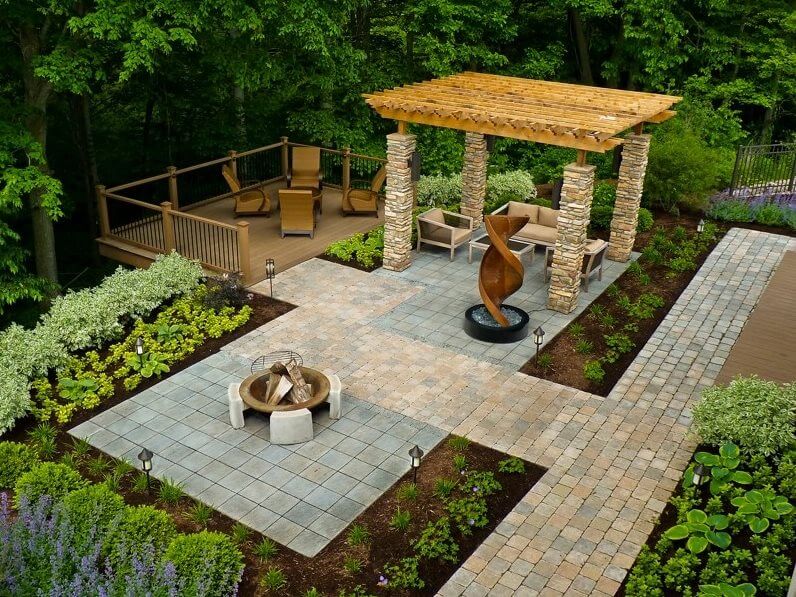Not known Facts About Landscapers
Table of ContentsLandscapers - The FactsLandscapers Things To Know Before You Get ThisUnknown Facts About LandscapersLandscapers - An OverviewLandscapers - The Facts
- A tree or shrub (shrub) that sheds its leaves in winter months. In the PNW there are semi-deciduous or semi-evergreen plants that may shed their leaves relying on how chilly the winter is. Abelia and some hebe are fine examples. Landscapers. - A level gathering room, made of timber or composite product (made to appear like wood), commonly adjacent or affixed to a structure.

- Granite that is weathered to the factor that it is an extremely fine aggregate. This is an all-natural process, and the result can be made use of for courses and outdoor patios. Broken down granite is frequently referred to as DG. It is specifically beneficial in contemporary landscapes. - Key landscape attributes being suggested in a landscape design strategy.
Getting My Landscapers To Work
These goals assist the layout process, not the designer's style or choices. Usual design goals in Portland are low maintenance, dry spell forgiving, and pet friendly.
Over time this layer can obtain very thick and make it challenging for water, sun, and nutrients to get to parts of the grass.- The procedure of accumulating and regulating the circulation of water on a building. This can be performed with grading, French drains pipes, dry wells, permeable surfaces, sump pump, rainfall yards, and extra.
- A sluggish feeding irrigation system that utilizes adaptable tubes and emitters to send an accurate amount of water to each plant. - The capacity of a plant to make it through without much summer water.
- A garden feature where water is represented by an aggregate rock item, normally a gravel or granite. These are most typically found in modern-day and Japanese yard design.- A stone or natural flagstone outdoor patio, path, or sidewalk developed without a concrete base. The base would be compressed crushed rock and the joints would be an accumulation or walkable ground cover.
Indicators on Landscapers You Need To Know
- A stone keeping or totally free standing wall developed without the use of mortar. - An underground structure that collect water and allows it to slow percolate into the dirt around it.
Landscape layout that works with a websites' atmosphere in both look and sustainability without unfavorable effects to the environment. Edging in the landscape is a line of separation that develops aesthetic rate of interest in the garden by separating one segment from an additional sector. This can be visual or practical, keeping one component (such as pea crushed rock) from getting mixed into an additional (like bark dirt).
Locations can likewise sense of "unit" supplied by trees, other growings, fences, or displays. The landscape near the entrance to a building. A tree, bush or vine, educated to grow on a wall surface or fence into a certain pattern. Particularly useful for fruit trees, try this making it very easy to harvest the fruit and having mess.
A plant that is foreign to the location where it will certainly be grown. Not all "exotics" are invasive or harmful, and several can be well behaved or dry spell forgiving (Landscapers). my explanation A mass planting of brushes. Thicker bladed turf lawn that spread out through rhizomes.: The degree of soil on your residential or commercial property before bark dust or compost is spread out.
Fascination About Landscapers

The purpose, reason, or activity that a location is be landscaped for. Stairways work, for instance, to allow foot traffic backwards and forwards an incline. Area for growing plants for viewing, eating, or physical task. A roofed structure utilized over an exterior celebration area. The sprouting of a seed, perhaps referring to a grass that is being expanded from seed.
Rock item, either rounded or fractured, that is relatively tiny- normally 1" or less. Reduced plants that are enabled or encouraged to spread out over a location. Can refer to any kind of "difficult" garden components including statuary or rocks however many commonly is utilized to describe paths, outdoor patios, and walls.: Height distinction between the degree of water in a pond (or the degree of the pump if it rests outside the fish pond) and the top electrical outlet of water which impacts performance of the water pump in gph (gallons per hour). Thick hedges or trees that form a fencing, screen, or border.

The 10-Second Trick For Landscapers
A more unwinded garden dominated by curved rather than straight bed lines and a much less inflexible framework. Standard PNW landscapes are informal. A plant that spreads even more than wanted, or right into habitats where it does damage. Rose city has a listing of intrusive plants that need to not be mounted in landscapes because they can infect woodlands or waterways and be challenging to control.
Can consist of head placements and insurance coverage, pipe sizing, GPM specifications, and materials required to install this system. Accredited expert that develops landscapes, educated in engineering and style as well as in horticulture.
The specialist who intends and develops landscape jobs, usually at a residential or tiny commercial degree with the significant style incentive on plantings. Landscape developers usually have much less schooling than Landscape Architects and are not certified. A finished landscape design, outlining all components for the new landscape. This normally takes the kind of a drawing theoretically.
Calcium product used to increase the pH in dirt, which will certainly make it less congenial to moss. A water limited HDPE product used underneath ponds, streams and waterfalls in water functions. Making use of many plantings of the exact same selection to fill out an area in the landscape. This can reduce upkeep and water usage in the garden.